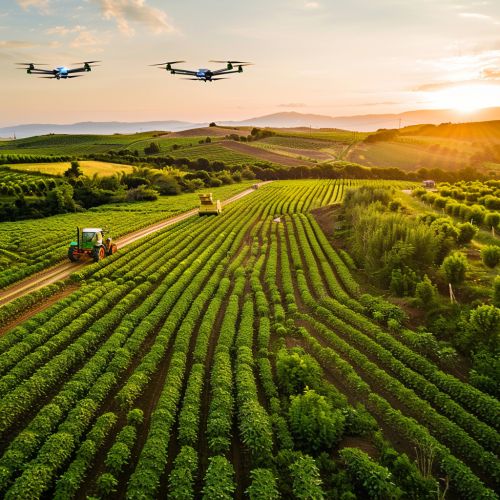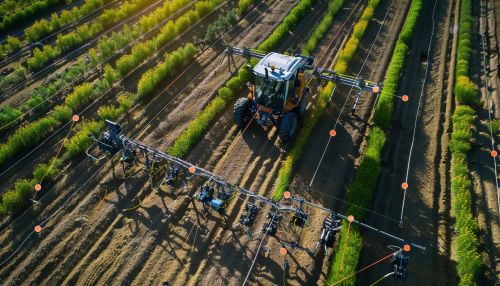Digital Agriculture: Difference between revisions
(Created page with "== Introduction == Digital agriculture, also known as precision agriculture or smart farming, refers to the integration of advanced digital technologies into agricultural practices to enhance productivity, efficiency, and sustainability. This field encompasses a wide range of technologies, including IoT, AI, big data, and GIS, among others. Digital agriculture aims to optimi...") |
No edit summary |
||
| Line 20: | Line 20: | ||
GIS technology is used to create detailed maps and models of agricultural fields. These maps can provide information on soil types, elevation, and water availability, among other factors. GIS data can be integrated with other datasets to create comprehensive models that guide precision farming practices. | GIS technology is used to create detailed maps and models of agricultural fields. These maps can provide information on soil types, elevation, and water availability, among other factors. GIS data can be integrated with other datasets to create comprehensive models that guide precision farming practices. | ||
[[Image:Detail-96155.jpg|thumb|center|Aerial view of a digitally monitored agricultural field with visible sensors and automated machinery.|class=only_on_mobile]] | |||
[[Image:Detail-96156.jpg|thumb|center|Aerial view of a digitally monitored agricultural field with visible sensors and automated machinery.|class=only_on_desktop]] | |||
== Applications of Digital Agriculture == | == Applications of Digital Agriculture == | ||
Latest revision as of 09:20, 4 July 2024
Introduction
Digital agriculture, also known as precision agriculture or smart farming, refers to the integration of advanced digital technologies into agricultural practices to enhance productivity, efficiency, and sustainability. This field encompasses a wide range of technologies, including IoT, AI, big data, and GIS, among others. Digital agriculture aims to optimize the use of resources, improve crop yields, and reduce environmental impact through data-driven decision-making.
Historical Background
The concept of digital agriculture has evolved significantly over the past few decades. The initial phase, often referred to as the Green Revolution, focused on the use of chemical fertilizers, pesticides, and high-yield crop varieties. However, the limitations of these methods, such as environmental degradation and diminishing returns, led to the exploration of more sustainable and technologically advanced solutions.
The advent of GPS technology in the 1990s marked a significant milestone, enabling farmers to precisely monitor and manage their fields. The subsequent development of IoT devices, AI algorithms, and big data analytics has further revolutionized the field, making it possible to collect, analyze, and act on vast amounts of agricultural data in real-time.
Key Technologies in Digital Agriculture
Internet of Things (IoT)
IoT devices play a crucial role in digital agriculture by providing real-time data on various parameters such as soil moisture, temperature, and crop health. These devices include sensors, drones, and automated machinery, all of which are interconnected through the internet. The data collected by IoT devices can be analyzed to make informed decisions about irrigation, fertilization, and pest control.
Artificial Intelligence (AI)
AI algorithms are used to analyze the data collected by IoT devices and other sources. Machine learning models can predict crop yields, detect diseases, and recommend optimal farming practices. AI-powered systems can also automate tasks such as planting, harvesting, and sorting, thereby reducing labor costs and increasing efficiency.
Big Data Analytics
Big data analytics involves the processing and analysis of large datasets to extract meaningful insights. In digital agriculture, big data can be used to identify trends, forecast weather conditions, and optimize supply chain management. Advanced analytics tools can also help in understanding consumer preferences and market demands, enabling farmers to make better business decisions.
Geographic Information System (GIS)
GIS technology is used to create detailed maps and models of agricultural fields. These maps can provide information on soil types, elevation, and water availability, among other factors. GIS data can be integrated with other datasets to create comprehensive models that guide precision farming practices.


Applications of Digital Agriculture
Precision Farming
Precision farming involves the use of digital technologies to monitor and manage agricultural practices at a micro-level. This approach allows for the precise application of inputs such as water, fertilizers, and pesticides, thereby reducing waste and improving crop yields. Precision farming techniques can also help in identifying and addressing issues such as soil erosion and nutrient deficiencies.
Smart Irrigation
Smart irrigation systems use IoT sensors and AI algorithms to optimize water usage. These systems can monitor soil moisture levels and weather conditions in real-time, adjusting irrigation schedules accordingly. Smart irrigation not only conserves water but also ensures that crops receive the right amount of moisture for optimal growth.
Crop Monitoring and Management
Digital agriculture technologies enable continuous monitoring of crop health and growth. Drones equipped with multispectral cameras can capture high-resolution images of fields, which can be analyzed to detect signs of stress, disease, or pest infestations. This information can be used to take timely corrective actions, minimizing crop losses and improving overall productivity.
Livestock Management
Digital technologies are also being used to enhance livestock management. IoT devices can monitor the health and behavior of animals, providing data on factors such as body temperature, movement patterns, and feeding habits. AI algorithms can analyze this data to detect early signs of illness and recommend appropriate interventions. Additionally, automated feeding and milking systems can improve efficiency and reduce labor costs.
Challenges and Limitations
Despite its numerous benefits, digital agriculture faces several challenges and limitations. One of the primary challenges is the high cost of implementing advanced technologies, which can be prohibitive for small-scale farmers. Additionally, the lack of digital literacy and technical expertise among farmers can hinder the adoption of these technologies.
Data privacy and security are also significant concerns, as the collection and sharing of agricultural data can expose farmers to risks such as data breaches and cyberattacks. Moreover, the integration of digital technologies into traditional farming practices requires substantial changes in infrastructure and management, which can be difficult to achieve.
Future Prospects
The future of digital agriculture looks promising, with ongoing advancements in technology and increasing awareness of its benefits. Emerging technologies such as blockchain and 5G connectivity are expected to further enhance the capabilities of digital agriculture. Blockchain can provide secure and transparent supply chain management, while 5G connectivity can enable faster and more reliable data transmission.
Research and development efforts are also focused on creating affordable and user-friendly solutions for small-scale farmers. Government initiatives and public-private partnerships can play a crucial role in promoting the adoption of digital agriculture, ensuring that its benefits are accessible to all.
Conclusion
Digital agriculture represents a significant leap forward in the quest for sustainable and efficient farming practices. By leveraging advanced technologies such as IoT, AI, big data analytics, and GIS, farmers can optimize resource usage, improve crop yields, and reduce environmental impact. While challenges remain, the continued development and adoption of digital agriculture hold the potential to transform the agricultural landscape, ensuring food security and sustainability for future generations.
